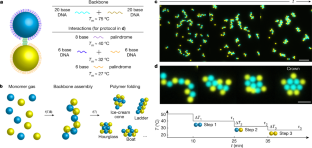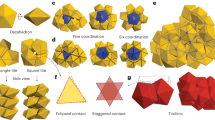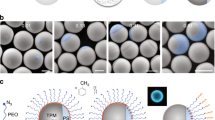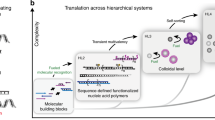Abstract
In the realm of particle self-assembly, it is possible to reliably construct nearly arbitrary structures if all the pieces are distinct1,2,3, but systems with fewer flavours of building blocks have so far been limited to the assembly of exotic crystals4,5,6. Here we introduce a minimal model system of colloidal droplet chains7, with programmable DNA interactions that guide their downhill folding into specific geometries. Droplets are observed in real space and time, unravelling the rules of folding. Combining experiments, simulations and theory, we show that controlling the order in which interactions are switched on directs folding into unique structures, which we call colloidal foldamers8. The simplest alternating sequences (ABAB...) of up to 13 droplets yield 11 foldamers in two dimensions and one in three dimensions. Optimizing the droplet sequence and adding an extra flavour uniquely encodes more than half of the 619 possible two-dimensional geometries. Foldamers consisting of at least 13 droplets exhibit open structures with holes, offering porous design. Numerical simulations show that foldamers can further interact to make complex supracolloidal architectures, such as dimers, ribbons and mosaics. Our results are independent of the dynamics and therefore apply to polymeric materials with hierarchical interactions on all length scales, from organic molecules all the way to Rubik’s Snakes. This toolbox enables the encoding of large-scale design into sequences of short polymers, placing folding at the forefront of materials self-assembly.
This is a preview of subscription content, access via your institution
Access options
Access Nature and 54 other Nature Portfolio journals
Get Nature+, our best-value online-access subscription
$29.99 / 30 days
cancel any time
Subscribe to this journal
Receive 51 print issues and online access
$199.00 per year
only $3.90 per issue
Buy this article
- Purchase on Springer Link
- Instant access to full article PDF
Prices may be subject to local taxes which are calculated during checkout




Similar content being viewed by others
Data availability
The data that support the findings of this study are available from the corresponding author upon request. The data includes experimental as well as computational datasets, Matlab scripts for experimental video analysis and Python scripts for computational dataset analysis.
Code availability
The custom computer codes to build folding trees, to identify foldamers and the Dissipative Particle Dynamics (DPD) code to simulate folding of colloidomers are available from the corresponding author upon request. We have provided pseudo-code for the enumeration code in Extended Data Figure 2. DPD is also available in open-source packages such as HOOMD and LAMMPS.
References
Ong, L. L. Programmable self-assembly of three-dimensional nanostructures from 10,000 unique components. Nature 552, 72–77 (2017).
Zeravcic, Z., Manoharan, V. N. & Brenner, M. P. Size limits of self-assembled colloidal structures made using specific interactions. Proc. Natl Acad. Sci. USA 111, 15918–15923 (2014).
Jacobs, W. M., Reinhardt, A. & Frenkel, D. Rational design of self-assembly pathways for complex multicomponent structures. Proc. Natl Acad. Sci. USA 112, 6313–6318 (2015).
Macfarlane, R. J. Nanoparticle superlattice engineering with DNA. Science 334, 204–208 (2011).
Wang, Y., Jenkins, I. C., McGinley, J. T., Sinno, T. & Crocker, J. C. Colloidal crystals with diamond symmetry at optical lengthscales. Nat. Commun. 8, 14173 (2017).
He, M. Colloidal diamond. Nature 585, 524–529 (2020).
McMullen, A., Holmes-Cerfon, M., Sciortino, F., Grosberg, A. Y. & Brujic, J. Freely jointed polymers made of droplets. Phys. Rev. Lett. 121, 138002 (2018).
Hill, D. J., Mio, M. J., Prince, R. B., Hughes, T. S. & Moore, J. S. A field guide to foldamers. Chem. Rev. 101, 3893–4011 (2001).
Rogers, W. B., Shih, W. M. & Manoharan, V. N. Using dna to program the self-assembly of colloidal nanoparticles and microparticles. Nat. Rev. Mater. 1, 16008 (2016).
Seeman, N. C. & Sleiman, H. F. DNA nanotechnology. Nat. Rev. Mater.3, 17068 (2017).
Talapin, D. V., Engel, M. & Braun, P. V. Functional materials and devices by self-assembly. MRS Bull. 45, 799–806 (2020).
Reches, M., Snyder, P. W. & Whitesides, G. M. Folding of electrostatically charged beads-on-a-string as an experimental realization of a theoretical model in polymer science. Proc. Natl Acad. Sci. USA 106, 17644–17649 (2009).
Coulais, C., Sabbadini, A., Vink, F. & van Hecke, M. Multi-step self-guided pathways for shape-changing metamaterials. Nature 561, 512–515 (2018).
Dodd, P. M., Damasceno, P. F. & Glotzer, S. C. Universal folding pathways of polyhedron nets. Proc. Natl Acad. Sci. USA 115, 6690–6696 (2018).
McMullen, A., Hilgenfeldt, S. & Brujic, J. Dna self-organization controls valence in programmable colloid design. Proc. Natl Acad. Sci. USA 118, e2112604118 (2021).
Zhang, Y. Multivalent, multiflavored droplets by design. Proc. Natl Acad. Sci. USA 115, 9086–9091 (2018).
Meng, G., Arkus, N., Brenner, M. P. & Manoharan, V. N. The free-energy landscape of clusters of attractive hard spheres. Science 327, 560–563 (2010).
Perry, R. W., Holmes-Cerfon, M. C., Brenner, M. P. & Manoharan, V. N. Two-dimensional clusters of colloidal spheres: ground states, excited states, and structural rearrangements. Phys. Rev. Lett. 114, 228301 (2015).
Zeravcic, Z. & Brenner, M. P. Spontaneous emergence of catalytic cycles with colloidal spheres. Proc. Natl Acad. Sci. USA 114, 4342–4347 (2017).
Holmes-Cerfon, M. C. Enumerating rigid sphere packings. SIAM Rev. 58, 229–244 (2016).
Trubiano, A. & Holmes-Cerfon, M. Thermodynamic stability versus kinetic accessibility: Pareto fronts for programmable self-assembly. Soft Matter 17, 6797–6807 (2021).
Bryngelson, J. D., Onuchic, J. N., Socci, N. D. & Wolynes, P. G. Funnels, pathways, and the energy landscape of protein folding: a synthesis. Proteins: Struct. Funct. Genet 21, 167–195 (1995).
Du, R. & Grosberg, A. Y. Models of protein interactions: how to choose one. Fold. Des. 3, 203–211 (1998).
Guarnera, E., Pellarin, R. & Caflisch, A. How does a simplified-sequence protein fold? Biophys. J. 97, 1737–1746 (2009).
Fink, T. M. & Ball, R. C. How many conformations can a protein remember? Phys. Rev. Lett. 87, 198103 (2001).
Zhang, Y. Sequential self-assembly of DNA functionalized droplets. Nat. Commun. 8, 21 (2017).
Oh, J. S., Lee, S., Glotzer, S. C., Yi, G.-R. & Pine, D. J. Colloidal fibers and rings by cooperative assembly. Nat. Commun. 10, 3936(2019).
Anfinsen, C. B. Principles that govern the folding of protein chains. Science 181, 223–230 (1973).
Gutin, A., Abkevich, V. & Shakhnovich, E. Is burst hydrophobic collapse necessary for protein folding? Biochemistry 34, 3066–3076 (1995).
Jiang, T., Magnotti, E. L. & Conticello, V. P. Geometrical frustration as a potential design principle for peptide-based assemblies. Interface Focus 7, 20160141 (2017).
Mohapatra, L., Goode, B. L. & Kondev, J. Antenna mechanism of length control of actin cables. PLoS Comp. Biol. 11, e1004160 (2015).
Friedrich, P. Supramolecular Enzyme Organization: Quaternary Structure and Beyond (Elsevier, 1984).
Marianayagam, N. J., Sunde, M. & Matthews, J. M. The power of two: protein dimerization in biology. Trends Biochem. Sci. 29, 618–625 (2004).
Zeravcic, Z., Manoharan, V. N. & Brenner, M. P. Colloquium: toward living matter with colloidal particles. Rev. Mod. Phys. 89, 031001 (2017).
Guerra, R. E., Kelleher, C. P., Hollingsworth, A. D. & Chaikin, P. M. Freezing on a sphere. Nature 554, 346–350 (2018).
Jerri, H. A., Sheehan, W. P., Snyder, C. E. & Velegol, D. Prolonging density gradient stability. Langmuir 26, 4725–4731 (2009).
Wang, Y. Colloids with valence and specific directional bonding. Nature 491, 51–55 (2012).
Pontani, L.-L., Jorjadze, I., Viasnoff, V. & Brujic, J. Biomimetic emulsions reveal the effect of mechanical forces on cell–cell adhesion. Proc. Natl Acad. Sci. USA 109, 9839–9844 (2012).
Zhang, D. Y. & Seelig, G. Dynamic DNA nanotechnology using strand-displacement reactions. Nat. Chem. 3, 103–113 (2011).
Mognetti, B. M., Leunissen, M. & Frenkel, D. Controlling the temperature sensitivity of dna-mediated colloidal interactions through competing linkages. Soft Matter 8, 2213–2221 (2012).
Lowensohn, J., Oyarzún, B., Paliza, G. N., Mognetti, B. M. & Rogers, W. B. Linker-mediated phase behavior of dna-coated colloids. Phys. Rev. X 9, 041054 (2019).
Srinivas, N. On the biophysics and kinetics of toehold-mediated DNA strand displacement. Nucl. Acids Res. 41, 10641–10658 (2013).
Groot, R. D. & Warren, P. B. Dissipative particle dynamics: bridging the gap between atomistic and mesoscopic simulation. J. Chem. Phys. 107, 4423–4435 (1997).
Wang, X., Ramírez-Hinestrosa, S., Dobnikar, J. & Frenkel, D. The Lennard-Jones potential: when (not) to use it. Phys. Chem. Chem. Phys. 22, 10624–10633 (2020).
Acknowledgements
We thank D. Pine, A. Grosberg, P. Chaikin, S. Hilgenfeldt, E. Clément, O. Rivoire and L. Leibler. This work was supported by the Paris Region (Région Île-de-France) under the Blaise Pascal International Chairs of Excellence. This work was also supported by the MRSEC programme of the National Science Foundation under grants No. NSF DMR-1420073, No. NSF PHY17-48958 and No. NSF DMR-1710163, the European Union’s Horizon 2020 research and innovation programme under the Marie Skłodowska-Curie grant agreement No. 754387, as well as by the city of Paris EMERGENCE(S) grant.
Author information
Authors and Affiliations
Contributions
A.M. designed the materials, synthesized the droplet system, performed the folding experiments and developed data analysis tools to extract time-dependent yields of foldamers. M.M.B. and Z.Z. constructed the theoretical model for generating folding trees and rigid states. M.M.B. developed the algorithm for enumerating foldamers, wrote the molecular dynamics codes and performed numerical simulations. J.B. and Z.Z. conceived the study and supervised the research. The manuscript was written by J.B. and Z.Z. together with A.M and M.M.B.
Corresponding authors
Ethics declarations
Competing interests
The authors declare no competing interests.
Peer review
Peer review information
Nature thanks Ning Wu and Menachem Stern and the other, anonymous, reviewer(s) for their contribution to the peer review of this work.
Additional information
Publisher’s note Springer Nature remains neutral with regard to jurisdictional claims in published maps and institutional affiliations.
Extended data figures and tables
Extended Data Fig. 1 Chain length distribution.
This panel shows a distribution of chain lengths from a typical chaining experiment, on a semi-log scale. Observed chains in the range N = 3−14 are exponentially distributed.
Extended Data Fig. 2 Flowchart of the foldamer search algorithm.
The top panel shows the ingredients required to run the algorithm: the ensemble of Hamiltonian paths {Hi,N}, a sequence, and a protocol. The input is a set of colored Hamiltonian paths embedded on the geometries, as shown for N = 7 and an alternate ABABABA sequence. The bottom panel outlines the main steps of the algorithm. In the figure, LM stands for Local Minimum, TS for Transient State and GM for Global Minimum.
Extended Data Fig. 3 Foldamer yields for an alternating ABAB sequence with length N = 6−13.
From left to right, we show the results for single, two, and three-step protocols. All yields are given as relative yields, in which the number of foldamers is normalized by the total number of rigid structures observed at the end of the corresponding protocol. The experimental number of observations is n6[ladder, triangle, chevron] = (67, 19, 86), n7[rocket#1, rocket#2, flower] = (175, 25, 7), n8[hourglass] = 8, n9[poodle] = 24 and n10[crown] = 8. ‘ND’ stands for ‘No Data’. Simulation yields YSimDownhill and YSimStepThermal come from two different protocols, the pure downhill and the step-thermalized quench, respectively, and result from averaging over > 2000 different initial conditions (sampling error is negligible). The significant difference between the two simulation protocols arises because the finite unbinding probability in the step-thermalized case is optimized to allow the colloidomer to escape kinetic traps, i.e., local minima, and fold correctly (see Supplementary Video 8 and the Extended Data Fig. 4(a)), whereas this is not possible in the downhill case. Exceptions are the N = 7 flower and N = 10 bed, foldamers that undergo geometric frustration, as the irreversibility of the locking bonds in the downhill protocol actually improves the yield. The two simulation methods give the range of yields one can access by folding strictly in 2D. Experiments undergo a finite temperature quench, which is better mimicked by the thermalized simulation protocol in all cases. Note that all but one (triangle) experimental yield fall within the range predicted by simulations. This experimental yield exceeds that of the optimized simulation, owing to the fact that local minima can be escaped by rare 3D excursions only possible in experiments.
Extended Data Fig. 4 Optimized foldamer yields for alternating and designed sequences.
(a) Relative foldamer yield YR(%) as function of bond strength ϵ/kBT for three foldamer structures: the ladder (blue), hourglass (orange) and crown (green). These structures exemplify foldamers resulting from 1-step, 2-step and 3-step protocols, respectively. The results were obtained by waiting τ = 103 time units (t. u.) with the first interaction on, and setting τ = 102 t. u. for subsequent interactions. We note that ϵ/kBT refers only to the binding strength during the first step in the protocol; subsequent steps in the protocol are treated as pure downhill folding. (b) Relative yields of the three foldamers in Fig. 4(b). As discussed in Extended Data Fig. 3, YSimDownhill corresponds to pure downhill folding, where the chain is likely to get trapped in a local minimum along the pathway. YSimStepThermal yields are the result of optimized binding strengths ϵ and quench lengths τ. Results in the table were obtained by setting τ = 103 t.u., and choosing ϵ/kBT = 8 for the N = 8 and N = 13 chains, and ϵ/kBT = 7 for the N = 11 chain.
Extended Data Fig. 5 Non-compact clusters in a hexagonal lattice in 2D.
The first non-compact cluster arises at N = 13; for N = 14 there are 6 different clusters, and for N = 15 we identify 41. All non-compact clusters contain a single hexagonal hole. For those structures colored in green, there exists at least one protocol in random sequence space that can fold them uniquely.
Supplementary information
Rights and permissions
About this article
Cite this article
McMullen, A., Muñoz Basagoiti, M., Zeravcic, Z. et al. Self-assembly of emulsion droplets through programmable folding. Nature 610, 502–506 (2022). https://doi.org/10.1038/s41586-022-05198-8
Received:
Accepted:
Published:
Issue Date:
DOI: https://doi.org/10.1038/s41586-022-05198-8
This article is cited by
-
Superstructural ordering in self-sorting coacervate-based protocell networks
Nature Chemistry (2024)
-
Synthesis of branched silica nanotrees using a nanodroplet sequential fusion strategy
Nature Synthesis (2023)
-
Self-organization of primitive metabolic cycles due to non-reciprocal interactions
Nature Communications (2023)
-
The First Nucleic Acid Strands May Have Grown on Peptides via Primeval Reverse Translation
Acta Biotheoretica (2023)
Comments
By submitting a comment you agree to abide by our Terms and Community Guidelines. If you find something abusive or that does not comply with our terms or guidelines please flag it as inappropriate.



